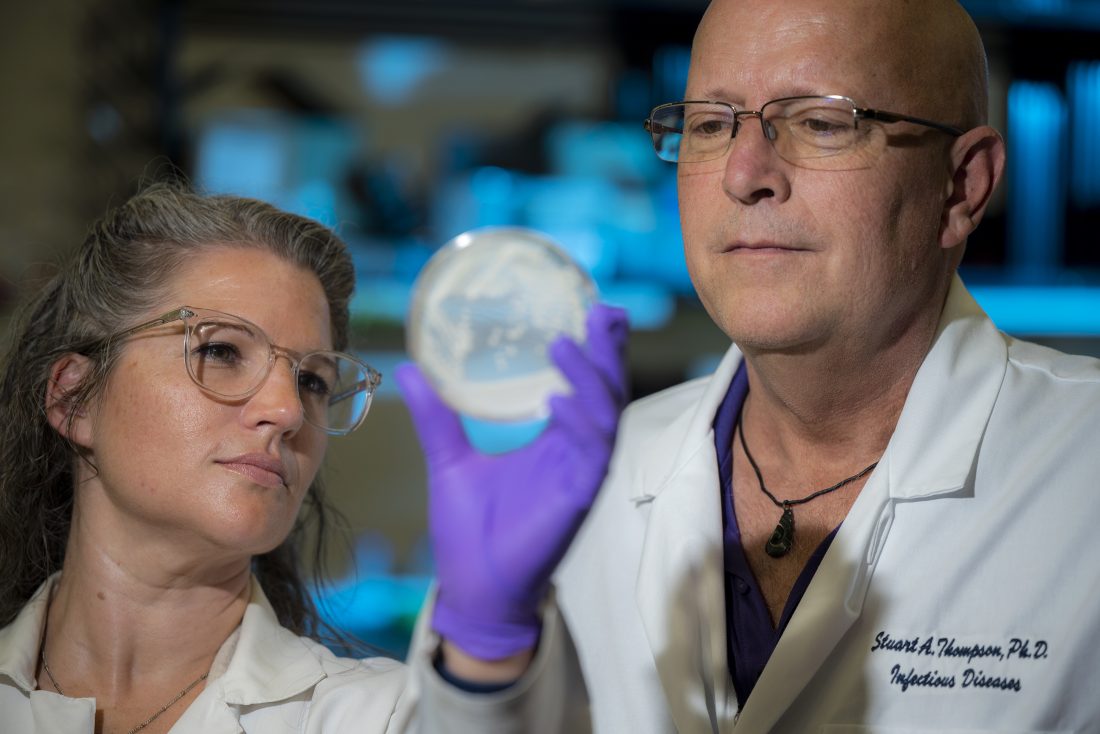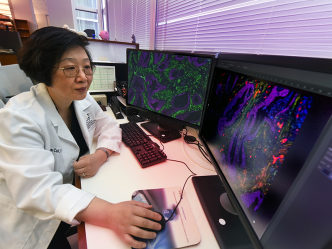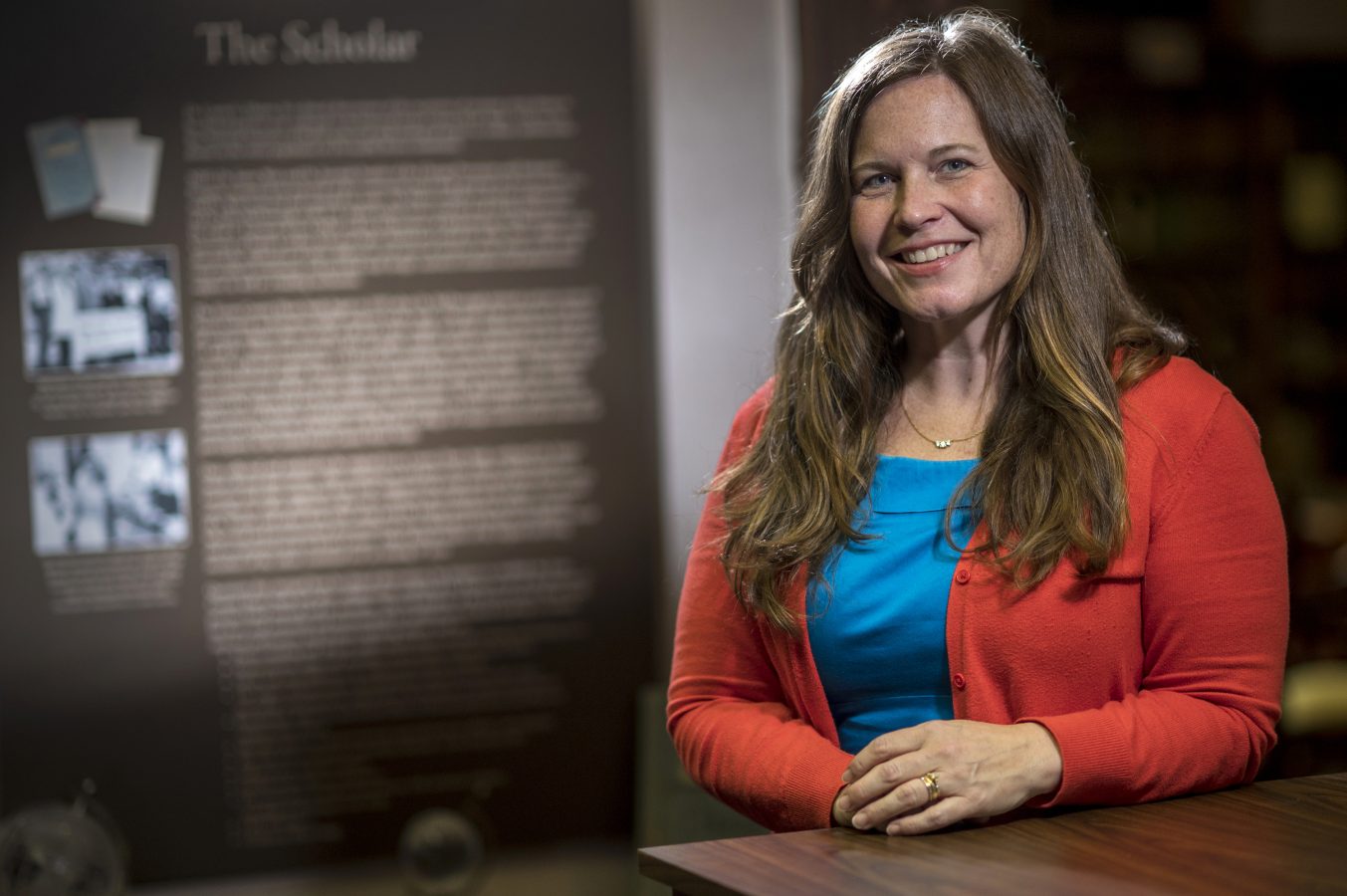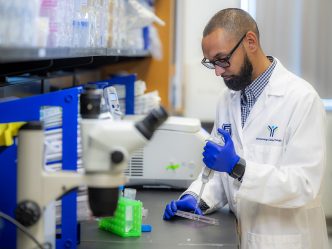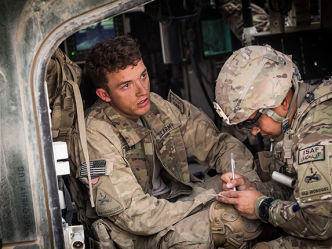As we head outdoors this summer, scientists are working to clip the long, flexible appendages that enable the common bacterium Campylobacter jejuni to make its way from undercooked poultry and natural waterways into our intestinal tract where it makes millions of us sick each year.
Campylobacter jejuni is the most common cause of diarrhea, vomiting and stomach pain in the United States and the world, with about 140 million cases worldwide and more than 30,000 deaths each year, primarily in children under age 5.
Motility is the “magic bullet” for this bacterium, which uses its long, thin, flexible arm-like flagella to maneuver the thick mucus in our gastrointestinal tract, power its way inside our intestinal cells, then wrap itself in a protective biofilm when threatened, says Dr. Stuart A. Thompson, microbiologist in the Division of Infectious Diseases at the Medical College of Georgia at Augusta University.
“It’s actually very good at moving, not only because of the flagellum, but because of the spiral shape of the cell itself, so it just travels through mucus,” says Dr. Claudia Cox, postdoctoral fellow, making a whooshing sound that mimics the whirling appendages.
The nimble flagella, each longer than the bacterium’s corkscrew-shape central body, don’t just propel, they help grab and hold onto the cell the bacterium is working to infect and push inside, she says. These essential arms, sticky because of their natural sugar coating, also play a role in building biofilm that will protect it from harsh times like too little food or too much oxygen.
Cox and Thompson want to stop the pervasive bacterium, potentially with a safe molecule that could be given as soon as signs of infection appear, like diarrhea and fever, by targeting elements key to its amazing mobility. But first they have to identify the best points of intervention.
They are looking at the enzyme CbrR, a so-called response regulator of the bacterium that enables it to assess its dynamic environment and make the adjustments it needs to survive. They also are taking the first looks in this bacterium at the “second messenger” cyclic-di-GMP, which the enzyme produces and uses to make those adjustments; and most recently the amino acids that function as building blocks for the bacterium’s long arms.
Thompson is principal investigator on a new two-year $423,500 grant (R21AI164078-01) from the National Institute of Allergy and Infectious Diseases that is helping them better understand those building blocks.
He’s also PI on a two-year, $410,000 grant (1R21AI154078-02) from the NIAID that ends this summer and has helped the scientists better understand how the bacterium uses cyclic-di-GMP to foster bile resistance — bile salt is a powerful antimicrobial — as well as motility/movement and the formation of the slick biofilm the bacterium shelters under when conditions get tough.
Cox and Thompson have shown that cyclic-di-GMP is produced by CbrR, which in this case is a negative regulator. They reported last year in the journal Microorganisms that when CbrR was present, both the mobility and the ability to produce biofilm were hampered. For example, the bacterium’s general corkscrew form was the same but the long, thin, constantly moving flagella were MIA, Thompson says.
“It turns out, CbrR is a regulator of motility, of flagella,” he says. “Motility is the number one most important virulence factor of Campylobacter. It’s required for colonization, it’s required for host-cell adherence and invasion, and it’s required for biofilm formation,” he says.
Bottom lines: CbrR is a good thing for Campylobacter jejuni because it makes cyclic-di-GMP and because it can downshift motility to help enable the bacterium to survive in a harsh environment, Cox says. That means it’s time to stop moving around so much, to conserve and look for something nearby — they have seen the bacterium pull starch out of a culture medium it was sitting in — to weave into biofilm or take shelter under some other bacterium’s biofilm, she says.
No doubt the super oxygen-sensitive bacterium often needs a port in the storm. Sit a dish of them on a desk for a few days and they are dead, Thompson says, just from the oxygen content in room air, he says. But unlike e coli, Campylobacter jejuni does need some oxygen. Water too, he says, which are some of the reasons why it’s happy in our gut and in the gut of poultry and migratory birds, he says, but notes that in birds, it’s part of their normal flora.
Key to making all these adjustments and the critical function of movement are amino acids, which combine to form proteins, and changes in amino acids can result in changes in a protein’s structure and function. It’s well known that bacteria use a process called phosphorylation, which is key to regulating many cell processes, to make the alterations needed to build out the flagella, a construction process that works kind of like adding Lego pieces from the ground up until it’s complete. Like with an actual building, there are a lot of regulators involved working to control growth, including stopping it when the time is right, which is where things like a negative regulator become important.
They have evidence that the amino acids serine and threonine, which they found are present in about half of flagella proteins, phosphorylate, or modify, proteins important to motility in that essential, dynamic building process. The new grant is enabling them to learn more about how phosphorylation of serine and threonine modify the bacterium’s proteins and what that does to the bug’s motility proteins with the goal again of finding the most direct target(s) for intervention. That might in this scenario include blocking phosphorylation instead of the resulting actions.
They already have identified two still unnamed proteins, 0215 and 0862, known to remove phosphates from serine and threonine, and have some evidence that 0215 may be involved in both adding and removing a phosphate group. They are looking for others that just add phosphates in this scenario.
This kind of addition and subtraction is important because when a protein has something added to it or taken away, it can change what the protein does, they say. “Sometimes it’s like an on/off switch and sometimes phosphorylation morphs the protein into doing something else,” Cox says.
Clever bacteria can slow down or resume the building of flagella depending on what’s happening in their environment, the scientists say. If they can identify a protein whose loss stops flagella construction, a small molecule that inactivates that protein could mean the important arms don’t get built, Thompson says.
While blocking key survival action of Campylobacter won’t work like a vaccine to try to block initial infection, the idea is that if they can block the growth of flagella needed for the bacterium’s movement, they can stop its progression in its tracks and early in the process, Thompson says.
The initial bacterial invaders would become more vulnerable to the natural immune response and/or simply die off, so the infection would be minor and unable to cause serious disease.
“It’s more of a targeted therapeutic,” Thompson says. “It’s dead in the water,” Cox adds.
The two also have studied both the primary sugar Campylobacter uses to make slimy, protective biofilm and how the regulatory protein CsrA helps. They showed long ago that when CsrA is missing, Campylobacter can’t move well, stick to each other or the gastrointestinal tract or make biofilm.
While the jury remains out on exactly where the biofilm comes from, they have some evidence it can be made by other bacteria and potentially elsewhere.
But Thompson adds there is also good evidence that the bacterium’s DNA is present in the biofilm but where the sugar, or polysaccharide, a major component, comes from remains unknown. He notes that the bacterium isn’t always covered in biofilm, like when it’s actively infecting a host and so rapidly replicating. “When our immune cells are spitting all kinds of nasty stuff” at the bacterium would likely be another good time to build biofilm and shelter, particularly when it’s a persistent infection, or when campylobacter runs across bile salt in our gut.
Undercooked poultry is a major source of Campylobacter jejuni, and so is animal poop, including from birds and cows, that ends up contaminating waters in lakes and ponds, Thompson says. While just how it causes disease remains unclear, most people recover in a week, often without antibiotic treatment.
Others develop irritable bowel syndrome, arthritis and the bacterium is the most common cause of Guillan-Barrè Syndrome, in which the immune system harms the nerves causing muscle weakness and potentially paralysis.
Antibiotic resistance by the bacterium can be a problem because of recent practices of feeding antibiotics to poultry as well as livestock to prevent illness, the scientists say.
Awareness may also be a problem. Despite the fact that it’s far more common than Salmonella, even when Thompson asks a roomful of scientists about Campylobacter jejuni, typically only a handful of hands go up.
 Augusta University
Augusta University
